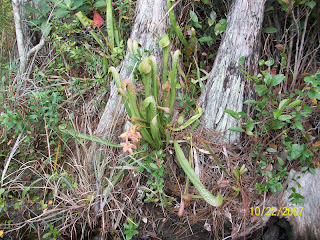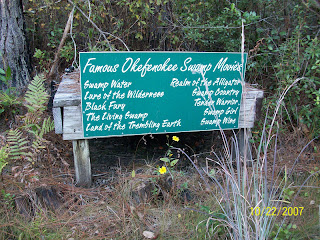We spent our days traveling around the Okefenokee Swamp, touring the towns of Folkston, Waycross, and Saint Marys along with the Submarine Museum. We have seen so much that I can't put it all in one blog so I will concentrated on the Okefenokee Swamp in this blog.
The Okefenokee Swamp Park is accessed on the northeastern side near the town of Waycross. The Okefenokee National Wildlife Refuge is accessed on the southeastern side near the town of Folkston.
Okefenokee "Land of the Trembling Earth".
As I mentioned in the last blog, I was not here since I was stationed in the Okefenokee for a couple of months while in the Army. At least I thought so but I discovered that the Stephen C. Foster State Park is located in the Okefenokee Swamp which Bev and I have been to a few years ago. The Stephen C. Foster State Park is accessed from Fargo which is on the the southwestern side. The Stephen C. Foster State Park is a wonderful, scenic park and we really enjoyed it when we were there.
The largest swamp in North America, the Okefenokee Swamp covers roughly 700 square miles and is located in the southeastern corner of Georgia, encompassing most of Charlton and Ware counties and parts of Brantley and Clinch counties. The swamp has a distinctive and fascinating natural history. Cypress swamps, winding waterways, and floating peat mats are a major part of the Okefenokee's habitat mosaic. Wet and dry prairies, swamps dominated by shrubs, and forests of blackgum and bay trees interspersed the array of other habitats. A high ridge of sand known as Trail Ridge forms the eastern edge of the swamp. Wildlife abound; more than 400 species of vertebrates, including more than 200 varieties of birds and more than 60 kinds of reptiles, are known to inhabit the swamp.
Oh yes, there are snakes in the swamp. Among the snakes, the federally protected indigo snake is the largest and also among the least likely to be encountered. The rare, brilliantly colored rainbow snake rivals the color scheme of any bird. Harmless water snakes are the most likely to be spotted in the Okefenokee. Cottonmouths, diamondback rattlesnakes, and canebrake rattlesnakes are the largest venomous species in the swamp. Supposedly copperhead snakes are not native to the swamp but are also here. I'm so glad we didn't run into any snakes!
When I was here in the Army I leaped over a diamondback rattlesnake while hiking down a path and one of the other soldiers got his combat boot bitten by a copperhead snake (he was not injured). One soldier killed a wild boar rooting near him. Fun times in the Army. It has been 50 years since I played in the swamp with the Army so I can't remember where I was in the swamp.
Logging operations began in 1910 and lasted for a quarter of a century, thousands of cypress, pine, and red bay trees were removed from the swamp. Some were among the largest and oldest individuals of their kind left in the country. In 1937 President Franklin D. Roosevelt provided official protection from logging and development by establishing the Okefenokee National Wildlife Refuge, which constitutes about 80 percent of the swamp. An additional 353,981 acres of the refuge were given additional protection as a National Wilderness area. The absence of roads helps to maintain the integrity of the swamp ecosystem; canoe trails are the primary travel routes through the swamp.
In the subtropical climate, rainfall is approximately fifty inches a year and is the source of most of the water entering the swamp from the more than 1,400 square miles of upland watershed. The clear, tannin-stained highly acidic waters of the Okefenokee generally are shallow, normally ranging up to depths of less than ten feet and averaging only two feet.
Most (about 85 percent) of the water leaving the Okefenokee is carried by the Suwannee River to the Gulf Coast of Florida. The St. Marys River, which flows into the Atlantic, drains the remainder of the swamp.
Indians occupied the Okefenokee during the late Archaic, Woodland, and Mississippian periods of Georgie prehistory.
Spanish records between 1602 and 1768 refer to the Okefenokee as Laguna de Oconi (Lake Oconi). At least two Timucuan villages and Spanish missions were located in or near the swamp between 1620 and 1656.
The Second Seminole War in Florida extended into the Okefenokee briefly in 1836 and for most of 1838. Roads and forts were built around the perimeter of the swamp. Georgia militia and U.S. Army troops patrolled intensively and burned a Seminole village on an island they subsequently renamed Floyds Island, for Charles Rinaldo Floyd. The Seminole band abandoned the swamp in 1838, but skirmishes continued to occur along the Georgia-Florida boundary as late as 1848.
A few white families settled on the southeastern edge of the Okefenokee as early as 1805. Settlers moved into the areas east, north, and west of the swamp after the land lottery of 1820.
Frequent wildfires play an important role in creating and maintaining Okefenokee's unique ecosystem. Some species of plants such as the Longleaf pine require fire for growth and to reduce competition. Fire also opens up the upland forests, improving conditions for wildlife species.
In 2007 the Big Turnaround Fire Complex burned a patchwork of shrubs, pine forest and grasslands within a perimeter of 386,722 acres, including nearly seventy-five percent of the Okefenokee National Wildlife Refuge. Prolonged drought conditions set the stage for this major wildfire event. Of course the adjacent commercial forest and private lands were not happy about the fire, yet fires within the Okefenokee NWR are considered a natural part of this complex ecosystem.
I guess I've written enough words about the swamp, lets look at some photos.
We were in the park a couple of days checking out the sights. The park is located on the northeast side of the Okefenokee near Waycross, GA.
Okefenokee Swamp Park Visitor Center
We took a shore train ride followed by a 45 minute boat ride into the swamp.
The train went by some of these exhibits then ended up at restored homestead which we toured.
A few miles from the site of the cabin on Sunday, July 22, 1838, Creek (Seminole) Indians massacred seven members of the Wilds family. This was the last Indian massacre in Georgia. Four sons escaped: Reuben, Jesse, James, John. A marker was placed here by their descendants, erected October 14, 1979.
After the train ride we headed out into the swamp on a boat. We were on the boat between 4:00 and 5:00 pm and got back to the visitor center just before dark. I'm glad the boat didn't breakdown in the swamp, there are to many things that want to eat you in the swamp.
Carnivorous Bug Eating Plant. (I can't remember it's name)
Gator's nest where they deposit their eggs to incubate.
See the Owl in the tree. He looked fake until he looked at us.
We stopped at this board walk and hiked to an observation tower to view the swamp from above. You can hike this boardwalk from the visitor center and not take the boat ride. ( They make you sign a waver to walk the boardwalk because of snakes, gators, and wild animals.) We took the easy way on the boat.
We arrived at this tower and hoofed it up to the top. What a view.
View from top of the tower
View half way up the tower
Another view half way up the tower (Spanish Moss)
View of board walk from tower
On the boat we passed this sign showing what movies were made in the swamp. There were some interesting stories of the actors in the swamp. Walter Brennan wrestled a gator and was really beaten up by it. Of course the gator was a blow up plastic gator. At the cabin we were in earlier, a lady was explaining all the famous people that were in the swamp. I couldn't leave it be, so I told her that I was a famous person in the swamp 50 years ago with the Army. She took my name, photo, and some information and said she was interested in anyone from the past that was in the swamp. Maybe my name will be listed along with Walter Brennan's. Yeah Sure!
Bears in their enclosure
One lonely Otter - he was begging for food.
Next the Okefenokee National Wildlife Refuge. We spent a couple of days touring the NWR. The Wildlife Refuge is accessed near Folkston, GA on the southeast side of the swamp. This is the Suwannee Canal Recreation Area.
The historic Suwannee Canal provides canoe and motorboat access to the vast, open "prairies" of the Okefenokee Swamp. The small natural lakes and gator holes dotting the prairies offer freshwater sport fishing. There are sandhill cranes, wood storks, and white ibis feeding in open marshes. Alligators, turtles, kingfishers, prothonotary warblers, and carnivorous plants are seen along the water's edge. Upland trails are excellent places to view endangered red-cockaded woodpeckers, gopher tortoises, turkeys, white-tailed deer, and longleaf pines.
We headed out into the swamp on a boat. This was a great scenic trip.
Yes, this is Bev heading out on the boat
See the turtle
Our boat captain is standing. The couple seated was also on a tour with us in Saint Marys. (Small World.)
It was a cooler day so the Gators were hiding but we did see a couple along the way.
Back at the visitor center we headed out on the Swamp Island Drive with our car. This is a scenic drive out to the Chesser Island Homestead.
The yellow flowers are Tick-Weed Sunflower
The Chesser Island Homestead is a restored homestead which shows how "swampers" once lived in the Okefenokee.
We had a lot of fun playing in the Okefenokee and saw a lot of awesome scenery. We are so glad we stayed in the area so we could see this wonderful place.
This finishes up the blog on the Okefenokee, the next blog will be on the rest of the places we have seen in the area. (Remember to click on the photos to enlarge.)
Tom and Bev livin and lovin the RV lifestyle.


























































No comments:
Post a Comment